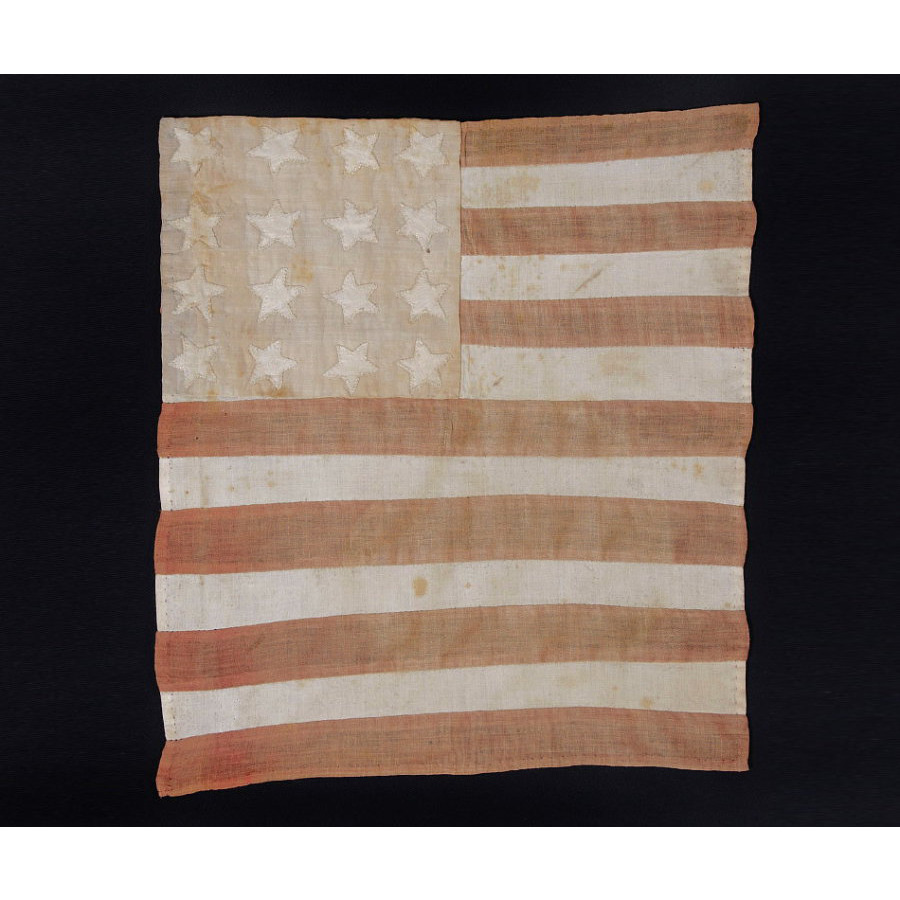
| |
WWI, BELGIAN-MADE FLAG WITH 16 STARS AND ITS CANTON RESTING ON THE WAR STRIPE, USED TO WELCOME U.S. SOLDIERS AFTER LIBERATION FROM THE GERMANS, 1918 |
|
| Available: |
Sold |
| Frame Size (H x L): |
|
| Flag Size (H x L): |
13" x 11.5" |
|
| Description....: |
|
WWI, BELGIAN-MADE FLAG WITH 16 STARS AND ITS CANTON RESTING ON THE WAR STRIPE, USED TO WELCOME U.S. SOLDIERS AFTER LIBERATION FROM THE GERMANS, 1918:
16 star American national flag with wonderful folk qualities, found in France along with a small Belgian flag of similar manufacture. The wonderful, make-do construction is indicative of American flags made in Europe during both WWI and also in WWII. Liberation flags were often made out of recycled materials, since shortages were a byproduct of war. The maker either did not know what the correct number of stars was that the flag was supposed to have, or though it impractical to include them all on such a small flag, especially given the available time and materials. The stripe count is correct, which is often the case.
The fact that the canton rests on a red stripe is a rare and desirable trait. Some flag historians refer to this as the "blood stripe" or the "war stripe", suggesting the flag was sometimes constructed in this manner when the nation was at war. There is evidence that the Navy used this design feature on at least some of its flags made during the mid-19th century. Sometimes the placement was merely by accident. When present, it most often occurs in flags made during the Civil War and during WWI. Whatever the case may be, it's a scarce feature that is extremely desired among collectors.
Belgium was ravaged by Germany during the First World War and terrible war crimes were reported. An old treaty between Belgium and Prussia (which became Germany) theoretically protected the nation from invasion, but was ignored because of the strategic advantages Belgium offered geographically for an attack on France. Persistent pressure from Britain and reporting of war crimes eventually persuaded American involvement.
The flag was found with a tiny Belgian flag of the same period that is constructed in similar fashion. The two were no-doubt made and waved together by a thankful Belgian family.
Construction: The flag is made of cotton. Like many homemade flags made in haste, this one is one-sided; most known examples share this trait. The background is a rectangular panel of pieced and sewn stripes, joined with treadle stitching and finished by hand with a blanket stitch on the reverse to keep the exposed edges from fraying. This unusual method is shared by the tiny Belgian flag. The canton was laid over top of the stripes, is hand-sewn, and has hand-sewn stars. The stars are finely hand-sewn and the stars point in various directions on their vertical axis, which gives them a strong folk quality that lends a nice accompaniment to their homemade nature.
Mounting: The flag has been hand-sewn to a background of 100% cotton twill, black in color, which was washed to reduce excess dye. An acid-free agent was added to the wash to further set the dye, which was heat-treated for the same purpose.
Condition: There is minor to moderate foxing and staining throughout. The canton has faded to a very light, dusty blue-grey, probably because the blue dye used had a fugitive pigment. The red stripes have faded to a persimmon color. The flag displays wonderfully. Many of my clients prefer early flags to show their age and history of use. |
|
|
|
| Collector Level: |
Advanced Collectors and the Person with Everything |
|
| Flag Type: |
Sewn flag |
|
| Star Count: |
16 |
|
| Earliest Date of Origin: |
1918 |
|
| Latest Date of Origin: |
1918 |
|
| State/Affiliation: |
Other |
|
| War Association: |
WW 1 |
|
| Price: |
SOLD |
|
| |
Views: 2804 |
|
|
|

